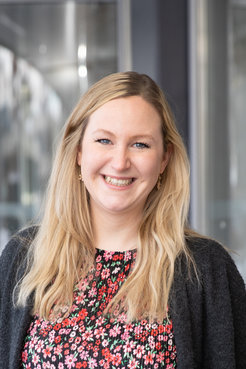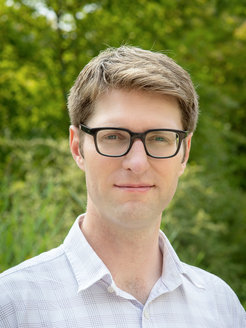ERC Consolidator Grants for Max Planck Researchers
Amelie Heuer-Jungemann and Karl Duderstadt each receive a Consolidator Grant from the European Research Council (ERC) for their submitted projects NanoCat and ChromoMemInMotion, worth up to 2 Mio Euro.
Amelie Heuer-Jungemann has been a research group leader at the Max Planck Institute (MPI) of Biochemistry since 2020. The ERC has awarded her with a Consolidator Grant for her NanoCat project, in which she will develop a new approach for the transfer of enzyme functions in living organisms. Karl Duderstadt, who in addition to his research work at the MPI of Biochemistry is an Associate Professor at the Technical University of Munich, is also being funded for his ChromoMemInMotion project. With the Consolidator Grants, the ERC supports excellent, promising scientists. Consolidator Grants are awarded up to 2 million euros for a period of 5 years.
The NanoCat project
All life depends on enzymatic reactions. These are used, among other things, when we are eating. For example, when we eat a potato, the enzymes in our saliva break down the starch contained in order to produce sugar. We can then use this as a source of energy. However, the introduction of "foreign" enzymes into other living organisms through genetic engineering often means that the enzymes cannot perform their tasks properly or even not at all, as the efficiency of such enzymes is naturally increased by encapsulation.
The NanoCat project aims to artificially develop such encapsulations. This is intended to preserve the function of the enzyme activity, even if they are introduced into organisms in which they normally do not occur. Together with Amelie Heuer-Jungemann's recently developed method, with which structures folded from DNA (DNA origami) remain stable but are still accessible for interaction with other molecules, NanoCat aims to develop a groundbreaking new tool.
NanoCat is a novel approach that allows enzymes to be used outside their natural environment in a functional way, for example to tackle health problems or global carbon emissions. It is crucial that the size, shape and function of the inserted enzyme encapsulations can be controlled. This will make it possible, for example, to equip plants with new or improved properties, such as significantly increased CO2 fixation without the use of genetic engineering.
About Amelie Heuer-Jungemann
Amelie Heuer-Jungemann studied chemistry with biochemistry at Heriot-Watt University in Edinburgh, UK. She completed her PhD in physics at the University of Southampton, UK, in 2015, where her focus was already on bionanotechnologies, and then worked there for a year as a postdoctoral fellow. She then worked, also as a postdoctoral fellow, at the physics faculty of the Ludwig Maximilians University of Munich until 2020 and then joined the Max Planck Institute of Biochemistry in Martinsried as Emmy Noether Research Group Leader for DNA Hybridnanomaterials.


The ChromoMemInMotion project
During cell division, our genetic information has to be copied. This involves the disassembly of millions of nucleosomes, the most basic units of chromosome organization, and separation of histones from DNA so that it can be read. At the end of this complex process, a copy of the DNA is created. On the histones are also markers that determine what type of cell it is. These are inherited epigenetically, meaning not via the DNA. However, it is not yet known how the assembly of new and old histones is coordinated during this process and how exactly it is ensured that the epigenetic markers are faithfully inherited.
In ChromoMemInMotion, Karl Duderstadt and his team are investigating the dynamics of histone processing by the replisome that helps to ensure chromosome maintenance and that cell identity is faithfully passed on from one generation to the next. In order to investigate the molecular mechanisms of the replisome during cell division, new imaging approaches will be developed in the course of the project to monitor the dynamic transfer and sorting of histones in real time and identify the underlying mechanisms.
The realization of these goals will represent a major breakthrough in our understanding of the molecular mechanisms of chromosome assembly and the transmission of epigenetic cell memory. In addition, the ChromoMemInMotion project will pave the way for biomedical technologies aimed at reprogramming epigenetic memories.
About Karl Duderstadt
Karl Duderstadt received his PhD in biophysics from UC Berkeley, CA, USA, in 2011. After a postdoctoral period as a research associate at the University of Groningen in the Netherlands, he became Max Planck research group leader of the Structure and Dynamics of Molecular Machines group at the MPI of Biochemistry in 2015. Since 2023, he is an Associate Professor in the new department of bioscience at the Technical University of Munich (TUM).
About the ERC
The European Research Council, ERC, was established by the European Union in 2007 and is the first European funding organization for outstanding research. Each year, the ERC selects and funds the best and most creative researchers of all nationalities and ages to carry out their projects in Europe. The ERC awards four types of grants: the "Starter Grant", the "Consolidator Grant", the "Synergy Grant" and the "Advanced Grant". The Consolidator Grant supports excellent, promising scientists whose own independent research group is still in the development or establishment phase. Consolidator Grants are awarded up to 2 million euros for a period of 5 years.
[tb]
Dictionary of the Research Group DNA Hybridnanomaterials:
Enzymes: Enzymes are small proteins that act as catalysts. This means that they accelerate biological reactions without changing themselves.
DNA: "DNA" stands for the English term deoxyribonucleic acid and is the name for genetic information. DNA contains the "genetic code", in other words the blueprint of a living organism.
DNA origami: DNA origami is a method in which long, single-stranded DNA molecules are folded into a desired shape using shorter ones. With the help of this technique, a wide variety of shapes just a few nanometers in size can be constructed with high precision.
Dictionary of the Research Group Structure and Dynamics of Molecular Machines:
DNA: "DNA" stands for the English term deoxyribonucleic acid and is the name for genetic information. DNA contains the "genetic code", in other words the blueprint of a living organism.
Histones: Histones are spherical proteins.
Nucleosomes: The nucleosome is the complex that the DNA forms with a histone.
Chromatin: Chromatin is the material that makes up chromosomes. It contains our DNA, which is packaged around histones in cell nuclei.
Chromosome: The chromosomes are the "X-shaped" state of our DNA, which is highly compressed in the cell nucleus.
Replisome: The replisome is the totality of all proteins and enzymes involved in the replication, i.e. duplication, of genetic information.













